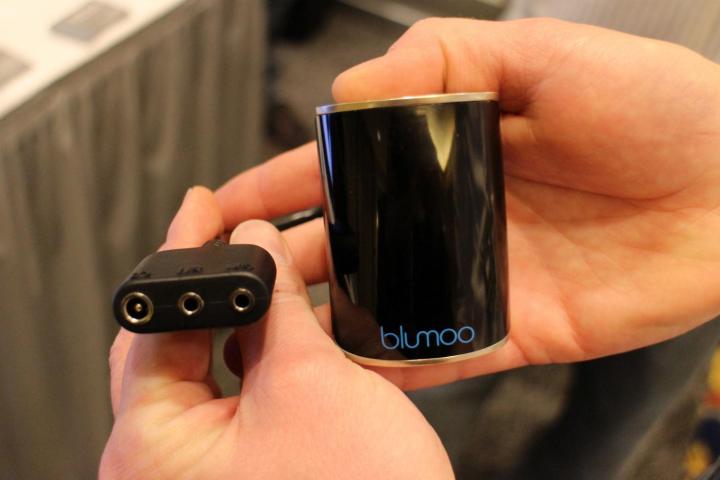
Check out our full Blumoo review.
Still have a barrage of remotes cluttering your coffee table to control your home theater system? Well, we’re well into the 21st century now, and it’s time to upgrade. Lucky for you, a new start-up called Flyover Innovations claims to have developed the ultimate solution for the multi-remote paradox — and from what we saw today at CES, we think they just might have it in the bag.
Flyover Innovations’ answer to universal control comes from a new device called Blumoo (pronounced Blue-Moo). The device employs a two-tier system, stemming from a dongle-like high-powered infrared sensor, and an impressively complete-yet-simple application for your iOS or Android mobile device. Through the application, you can pair your mobile device to the Blumoo dongle over Bluetooth, which then transmits remote commands to all of your devices by shooting high powered infrared beams off the walls of your home. And somewhat surprisingly, even in the clutter of a CES convention ballroom, it works very well.
Blumoo doesn’t stop there, though. It incorporates some extremely clever features that just beg you to forgo similar applications or 
But perhaps the most impressive additional feature, for audio enthusiasts anyway, is the Blumoo dongle’s inclusion of a 3.5mm audio output, making it a wireless adaptor that allows you to stream music to your stereo from iTunes, Spotify, and Google Play. And even without the app, we were able to stream to the Blumoo from our phone at Flyover Innovations’ booth. Are you starting to get the picture as to why we’re excited about this system?
The Blumoo also includes a hardwired infrared output for any components you may have tucked away from its infrared range. The system uses Bluetooth 4.0, allowing for fast and clean audio transfers, and it also employs a secondary Bluetooth stream for data on iOS devices, with a monstrous claimed range of 150 feet.
We’re skeptical about streaming from that distance, and weren’t able to perform a fair test in the packed halls of the Venetian ballroom. Our other main concern is the amount of power demands Blumoo will put on the average mobile device. The reps at the show claimed it is extremely energy-efficient, and also has an auto disconnect to save power when you’re not using remote commands. Again, we were unable to substantiate those claims in our quick encounter with Blumoo, but we’ve set an order of a review sample, so we should be able to give you a lot more feedback on the system in the coming weeks.
Blumoo will be available sometime in the early months of 2014 for $100.
Editors' Recommendations
- You Asked: VR home theater, universal remotes, and Dolby Atmos music
- Roku blazes a wireless audio trail for new soundbars at CES 2021


